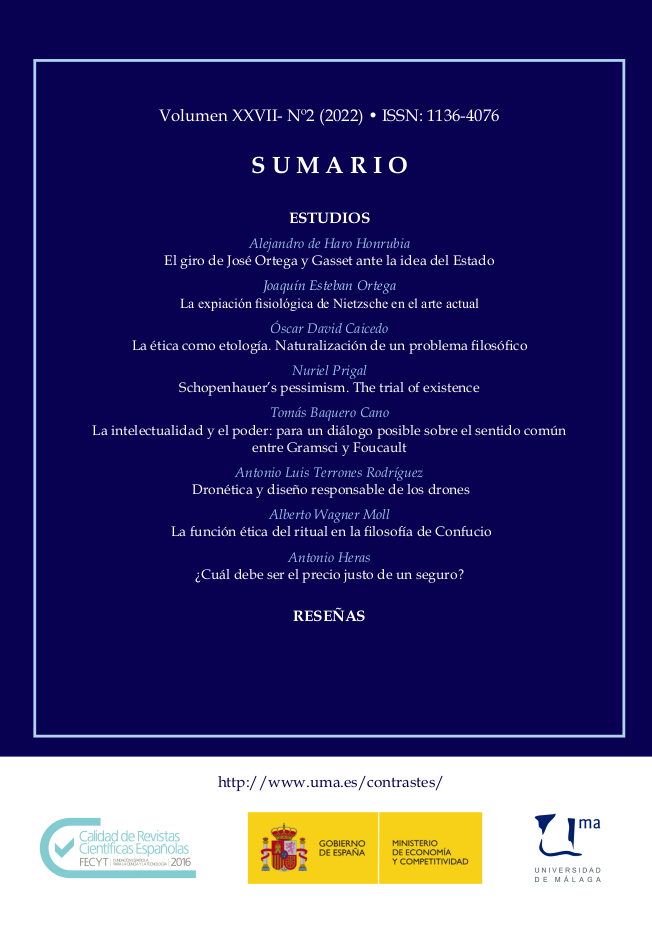Nietzsche's physiological atonement in today's art
DOI:
https://doi.org/10.24310/Contrastescontrastes.v27i2.12319Keywords:
Nietzsche, Hermeneutical Physiology, Atonement, Body ArtAbstract
The fact that, for Nietzsche, our body interprets on the instinctual sustenance of unconscious forces, has the consequence of blurring the security of the constituent and unifying privilege of consciousness. The fragmentation implicit in hermeneutic physiology allows the affirmation of life in all its dimensions. Understanding the drives as interpretative projections of the will to power involves the ratification of excellence, but, at the same time, the abyss of the accursed part. This tragic agon, so recognizably Nietzschean, seems to have had no choice but to express its contradiction in the expiatory character of some examples of current body art.
Downloads
Metrics
References
ADELL, A. 2011: El arte como expiación. Madrid: Casimiro.
AZNAR ALMAZÁN, S. 2006: El arte de acción. Madrid: Nerea.
AZNAR ALMAZÁN, S. y MARTÍNEZ PINO, J. 2009: Últimas tendencias del arte. Madrid: Editorial universitaria Ramón Areces.
CONILL SANCHO, J. 1997: El poder de la mentira. Nietzsche y la política de la transvaloración. Madrid: Tecnos.
CONILL SANCHO, J. 2019: Intimidad corporal y persona humana. De Nietzsche a Ortega y Zubiri. Madrid: Tecnos.
CRUZ SÁNCHEZ, P.A. 2013: Cuerpo, ingravidez y enfermedad. Barcelona: Bellaterra.
DEL VALLE CORDERO, A. (2013), «Ana Mendieta: Performance a la manera de los primitivos», Arte, Individuo y Sociedad, 26 (1) pp. 67-82.
DELEUZE, G. 2002: Nietzsche y la filosofía. Barcelona: Anagrama.
FOUCAULT, M. 2019: Historia de la Sexualidad IV. Las confesiones de la carne. Madrid : Akal.
GUASCH, A. M. 2007: El arte último del siglo XX. Del postminimalismo a lo multicultural. Madrid: Alianza.
JARA, J. (2009), «Hermenéutica genealógica desde el cuerpo», Estudios Nietzsche. Nietzsche y la hermenéutica, IX, pp. 15-23;
JARA, J. 1998: Nietzsche, un pensador póstumo. El cuerpo como centro de gravedad. Barcelona: Anthropos.
NIETZSCHE, F. 2010-2016: Obras completas. Madrid: Tecnos.
NIETZSCHE, F. 2006-2010: Fragmentos póstumos. Madrid: Tecnos.
ONFRAY M. 2011: La Construction du surhomme. Paris: Graset.
ONFRAY, M. 2011: Freud. El crepúsculo de un ídolo. Madrid: Taurus.
OTERO LEÓN, L. (2008), «De la estética como fisiología en Nietzsche a la curación como obra de arte en Gadamer», Contrastes, Revista Internacional de Filosofía, XIII, pp. 19-35,
RUDINESCO, E. 2011: ¿Por qué tanto odio? Buenos Aires: Libros del Zorzal.
SALGADO, E. 2007: Cumbre y abismo en la filosofía de Nietzsche. El cultivo de sí mismo, Madrid, Plaza y Valdés.
SÁNCHEZ MECA, D. (2001), «Nietzsche o el sueño de la gran salud», Paideía, 58, pp. 505-522.
SÁNCHEZ MECA, D. (2002), «Psicofisiología nietzscheana del arte y de la decadencia», en J. Rivera de Rosales y Mª. C. López Sáez (Coords.), El cuerpo. Perspectivas filosóficas. Madrid: UNED, pp. 107-132.
SÁNCHEZ MECA, D. (2009), «Voluntad de poder e interpretación como supuestos de todo proceso orgánico», Estudios Nietzsche, 9, pp. 105-122.
SÁNCHEZ MECA, D. 1989: En torno al superhombre. Nietzsche y la crisis de la modernidad. Barcelona: Anthropos.
SÁNCHEZ MECA, D. 2005: Nietzsche. La experiencia dionisiaca del mundo, Madrid, Tecnos.
SANTIAGO GUERVÓS, L. E. 2004: Arte y poder. Aproximación a la estética de Nietzsche. Madrid: Trotta,
SEDEÑO VALDELLÓS, A. (2010), «Cuerpo, dolor y rito en la performance: Las prácticas artísticas de Ron Athey», Nómadas. Revista Crítica de Ciencias Sociales y Jurídicas, 27.
SEGALEN, M. 2005: Ritos y rituales contemporáneos. Madrid: Alianza.
SOLÁNS, P. 2007: Accionismo vienés. Madrid: Nerea.
VALLE-CORDERO, A. (2014), “Ana Mendieta: Performance a la manera de los primitivos”, Arte, individuo y sociedad, 26 (1) pp. 67-82.
Downloads
Published
How to Cite
Issue
Section
License
This journal provides immediate free access to its content under the principle of making research freely available to the public. All content published in Contrastes. Revista Internacional de Filosofía, are subject to the Creative Commons Attribution-NonCommercial-ShareAlike 4.0 license whose full text can be found at <http://creativecommons.org/licenses/by-nc-sa/4.0>
It is the responsibility of the authors to obtain the necessary permissions of the images that are subject to copyright.
Authors whose contributions are accepted for publication in this journal will retain the non-exclusive right to use their contributions for academic, research and educational purposes, including self-archiving or repository in open access repositories of any kind.
The electronic edition of this magazine is edited by the Editorial Service of the University of Malaga (Uma Editorial), being necessary to cite the origin in any partial or total reproduction.









5.png)
